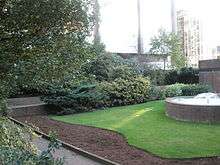Church of Holy Trinity, Minories

Holy Trinity, Minories, was an Anglican parish church outside the eastern boundaries of the City of London; but within the Liberties of the Tower of London. The liberty was incorporated in the Metropolitan Borough of Stepney in 1899, and today is within the City of London. Converted from the chapel of a nunnery, Holy Trinity was in use from the 16th century until the end of the 19th century.
History
The parish covered an area previously occupied by the precincts of a convent of St Clare, founded by Edmund Crouchback, in 1293, for a group of Spanish nuns of the Order of St. Clare who arrived with his wife.[1] The nuns were also known as the Minoresses – which came to be adapted as the name for the district, Minories. The nunnery was surrendered to the Crown in 1539, during the Dissolution of the Monasteries,[1] and the buildings, excluding the chapel, were used as an armory for the Tower of London, and later, as a workhouse. Some of the abbey buildings survived until their destruction by fire in 1797.[2]
The nuns' chapel became a parish church. Considerable changes were made to the building: all the ancient monuments were removed, a gallery, a new pulpit and pews were installed, and a steeple was built.[3] The first recorded reference to a dedication to the Holy Trinity dates from 1563.[4] Later in the 16th century, the church was a Puritan stronghold, where both John Field and Thomas Wilcox preached.[5] Until 1730, the church claimed the rights of a royal peculiar – including freedom from the authority of the Bishop of London; and the right to perform marriages "without licence".[6]
The church escaped the Great Fire of London [7] but fell into disrepair and was rebuilt in brick in 1706, retaining the north wall of the medieval building.[8] The new church was a plain structure, a single space undivided by pillars or columns,[9] 63 feet (19 m) long and 20 feet (6.1 m) wide, built at a cost of £700.[10] The bells were housed in a wooden turret above the projecting porch.[9]
Closure and destruction
In 1899, the church was closed under the provisions of the Union of Benefices Act 1860[11] and united with the parish of St Botolph's Aldgate. The former church was used as a parish room until destroyed by bombing during the Second World War.[2] The medieval north wall survived until the clearance of the site in 1956–8.[12]
References
- 1 2 East of London FHS
- 1 2 "Trinity (Minories) Aldgate Bus Station, Archaeological impact assessment" (PDF). City of London.
- ↑ Tomlinson 1907, pp. 241–87
- ↑ Tomlinson 1907, p.162
- ↑ http://www.anglicanbooksrevitalized.us/Peter_Toons_Books_Online/History/puritanscalvinism.htm
- ↑ "Transport Office - Trinity (Holy) the Less Lane". A Dictionary of London. 1918. Retrieved 11 January 2009.
- ↑ Church bells web site
- ↑ Tomlinson 1907, p.264
- 1 2 "Stepney". An Inventory of the Historical Monuments in London, Volume 5: East London. 1930. pp. 69– 101. Retrieved 18 January 2014.
- ↑ Hughson 1805, p,186
- ↑ The Times, Tuesday, 20 June 1899; pg. 8; Issue 35860; col A Ecclesiastical Intelligence Ancient church closes
- ↑ Collins 1960, p.160
Sources
- Collins, F.J. (1961). "Notes on the Church of Holy Trinity Minories". Transactions of the London and Middlesex Archaeological Society. 20: 160– 5.
- Hughson, David (1805). London. 2. London: J. Stratford. p. 186. Retrieved 5 December 2011.
- Tomlinson, Edward Murray (1907). A History of the Minories. London: Smith, Elder & Co.
Coordinates: 51°30′41″N 0°04′29″W / 51.5115°N 0.0746°W